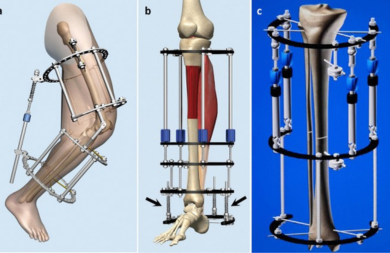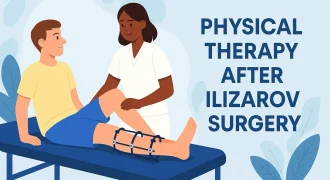Ilizarov surgery is a specialized orthopedic procedure used to treat complex bone problems such as fractures, deformities, and limb length discrepancies. Named after the Russian surgeon Gavriil Ilizarov, this technique has revolutionized bone reconstruction by using a unique circular external fixator — the Ilizarov apparatus.
If you or a loved one is facing a condition that might require this surgery, understanding the procedure can help ease concerns and prepare you for what lies ahead. Let’s break down the process step-by-step.
What is Ilizarov Surgery?
At its core, Ilizarov surgery involves the gradual realignment, lengthening, or reshaping of bones using a circular frame made of metal rings and wires. This device is fixed externally around the affected limb, allowing controlled adjustments over time. It’s especially useful for:
- Non-healing fractures (non-unions)
- Bone defects and gaps
- Limb length discrepancies (one leg shorter than the other)
- Complex bone deformities
- Infected or damaged bones needing reconstruction
Step 1: Preoperative Assessment and Planning
Before the surgery, your orthopedic surgeon will perform a thorough evaluation, which includes:
- Detailed medical history and physical exam
- Imaging studies like X-rays, CT scans, or MRI to analyze the bone problem in detail
- Planning the exact placement of the Ilizarov frame and the surgical steps needed
This stage is crucial because the success of the surgery depends on precise planning tailored to your specific bone condition.
Step 2: Anesthesia and Preparation
On the day of surgery, you will be admitted to the hospital and prepared for the operation. The procedure usually requires general anesthesia, which means you will be asleep and pain-free throughout.
The affected limb will be cleaned and sterilized carefully to reduce infection risks. Surgical drapes will cover the rest of your body to maintain a sterile environment.
Step 3: Application of the Ilizarov Frame
The surgeon begins by making small incisions in the skin and inserting thin wires or pins into the bone. These wires are then attached to the circular metal rings, which surround the limb externally.
- The rings are connected by adjustable rods.
- This frame holds the bone fragments in the desired position.
- The wires are tensioned carefully to provide stability.
Because the frame is external, it allows for adjustments even after surgery without reopening the limb.
Step 4: Bone Cutting (Osteotomy)
In cases where bone lengthening or deformity correction is needed, the surgeon will perform an osteotomy — a precise surgical cut through the bone.
This cut allows the bone to be gradually pulled apart or realigned as healing progresses.
Step 5: Gradual Adjustment and Healing
The real magic of Ilizarov surgery happens after the operation.
- The patient or caregiver is taught how to adjust the frame daily.
- By turning screws on the external frame, the bone segments slowly move — usually at about 1 millimeter per day.
- This gradual distraction stimulates new bone growth in the gap created.
The process may take weeks or months depending on how much lengthening or correction is required.
Step 6: Regular Follow-Up and Monitoring
Regular check-ups are essential. Your surgeon will:
- Take periodic X-rays to monitor bone growth and alignment
- Adjust the frame settings if necessary
- Look for signs of infection or complications
Patients are also encouraged to perform physical therapy to maintain joint mobility and muscle strength.
Step 7: Frame Removal
Once the bone has healed fully and achieved the desired correction, the Ilizarov frame is removed. This minor procedure usually involves cutting the wires and rings away.
After frame removal, a cast or brace might be used temporarily to protect the limb while it regains full strength.
Recovery and Rehabilitation
Recovery from Ilizarov surgery requires patience and commitment. Since the frame is on the outside, it demands good hygiene and care to avoid infections.
Physical therapy plays a big role in regaining full function and movement. Patients often return to normal activities gradually over months after the frame is removed.
Risks and Considerations
Like any surgery, Ilizarov procedure has some risks:
- Pin site infections (most common, treatable with antibiotics)
- Joint stiffness
- Nerve or blood vessel injury (rare)
- Pain or discomfort from the frame
Choosing an experienced surgeon and following all care instructions can minimize these risks.
Final Thoughts
Ilizarov surgery is a remarkable technique that can restore function and correct challenging bone problems that were once considered untreatable. Though it requires a lengthy healing process, the results often dramatically improve quality of life.
If you’re exploring treatment options for complex bone issues, talk to an orthopedic specialist about whether Ilizarov surgery might be right for you. Understanding the steps and commitment involved will help you face the journey with confidence and hope.
Contact Dr. Divya Ahuja for more details.
Our Clinical Locations
Tap a location to view timings, contact, and map.
Broadway Healthcare, Dadar East
Broadway Healthcare, Dadar East
Clinic Info
- 📍 Broadway Healthcare, Dadar East, Mumbai
- 🕒 Wednesdays · 10:00 AM – 12:00 NOON
- 📞 Appointments: +91 93213 17227
Sweet Clinics, Vashi, Navi Mumbai
Sweet Clinics, Vashi, Navi Mumbai
Clinic Info
- 📍 Sweet Clinics, Vashi, Navi Mumbai
- 🕒 Fridays · 10:00 AM – 12:00 NOON
- 📞 Appointments: +91 93213 17227
Heal Well Speciality Clinic, Thane West
Heal Well Speciality Clinic, Thane West
Clinic & OPD Info
- 📍 Heal Well Speciality Clinic, Thane West
- 🕒 Every Wednesday 10:00 AM – 11:00 AM
- 📞 Appointments: +91 81691 04438
Mangal Anand Hospital, Chembur Mumbai
Mangal Anand Hospital, Chembur Mumbai
Clinic & OPD Info
- 📍 Mangal Anand Hospital, Chembur Mumbai
- 🕒 Monday, Wednesday, Friday 03-07 PM, Thursday 06-07 PM, Free OPD Saturday 02-04 PM
- 📞 Appointments: +91 70212 18182









